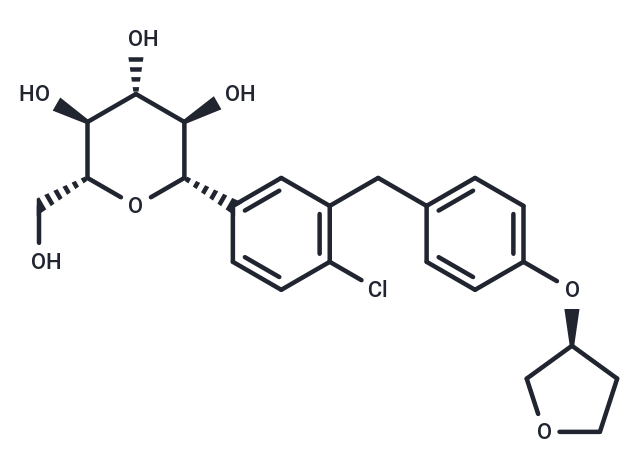Shopping Cart
Remove All Your shopping cart is currently empty
Your shopping cart is currently empty
Empagliflozin (BI 10773) is an SGLT-2 inhibitor (IC50=3.1 nM) that is potent and selective, with more than 300-fold selectivity for SGLT-1/4/5/6. Empagliflozin is used for the treatment of type 2 diabetes.

| Pack Size | Price | USA Warehouse | Global Warehouse | Quantity |
|---|---|---|---|---|
| 5 mg | $39 | In Stock | In Stock | |
| 10 mg | $55 | In Stock | In Stock | |
| 50 mg | $72 | In Stock | In Stock | |
| 100 mg | $97 | In Stock | In Stock | |
| 200 mg | $147 | In Stock | In Stock | |
| 500 mg | $198 | In Stock | In Stock | |
| 1 g | $292 | In Stock | In Stock | |
| 1 mL x 10 mM (in DMSO) | $43 | In Stock | In Stock |
| Description | Empagliflozin (BI 10773) is an SGLT-2 inhibitor (IC50=3.1 nM) that is potent and selective, with more than 300-fold selectivity for SGLT-1/4/5/6. Empagliflozin is used for the treatment of type 2 diabetes. |
| Targets&IC50 | SGLT2:3.1 nM, SGLT4:11 μM, SGLT5:1.1 μM, SGLT6:2 μM, SGLT2:57 ± 37 nM (Kd), SGLT1:8.3 μM |
| In vitro | In kinetic binding experiments, [3H]-Empagliflozin exhibited high affinity for SGLT-2 in the absence of glucose, demonstrating an average Kd of 57 nM and a half-life of binding to SGLT-2 of 59 minutes. Empagliflozin competitively binds to SGLT-2 against glucose. The selectivity of Empagliflozin for hSGLT-2 was substantially higher compared to other glucose transporters: 2500 times greater than hSGLT-1 (IC50 8300 nM), over 3500 times that of hSGLT-4, more than 350 times that of hSGLT-5 (IC50 = 1100 nM), and over 600 times that of hSGLT-6. Additionally, at a concentration of 10 μM, Empagliflozin did not inhibit GLUT1. |
| In vivo | Long-term treatment with Empagliflozin can improve blood glucose control and characteristics of metabolic syndrome in diabetic rats. After treating dogs with 5 mg/kg Empagliflozin for 24 hours, plasma concentrations were over 100 times higher than the measured IC50 value. The total plasma clearance rate for Empagliflozin in ZDF rats was 43 mL/min/kg, compared to 1.8 mL/min/kg in dogs. The Cmax for ZDF rats and dogs treated with Empagliflozin were respectively 167 nM and 17254 nM. Additionally, the bioavailability of Empagliflozin in ZDF rats was 33.2%, whereas it reached up to 89.0% in dogs. |
| Kinase Assay | [14C]-monosaccharide uptake inhibition experiments: Stable cell lines over-expressing hSGLT-1, -2, -4, -5 or -6 or rSGLT-1 or -2 are used for the sodium-dependent monosaccharide transport inhibition assay. Cells are pre-incubated in 200 μL uptake buffer (10 mM HEPES, 137 mM NaCl, 5.4 mM KCl, 2.8 mM CaCl2, 1.2 mM MgCl2, 50 μg/ml Gentamycin, 0.1% BSA) for 25 minutes at 37°C. 10 μM Cytochalasin B and test compound is added at different concentrations 15 minutes before the initiation of the uptake experiment. The uptake reaction is started by the addition of 0.6 μCi [14C]-labelled monosaccharide i.e. [14C]-labelled AMG, glucose, fructose, mannose or myo-inositol, in 0.1 mM AMG (or the respective non-radioactive monosaccharide). After incubation for 60 minutes (hSGLT-5), 90 minutes (hSGLT-4) or 4 hours (hSGLT-2) at 37°C, the cells are washed three times with 300 μL PBS and then lysed in 0.1 N NaOH with intermittent shaking for 5 minutes. The lysate is mixed with 200 μL MicroScint 40 and shaken for 15 minutes and counted for radioactivity in the TopCount NXT. For SGLT-4 and SGLT-5 assays cells are pre-incubated in pre-treatment buffer (uptake buffer containing choline chloride instead of NaCl) for 25 minutes prior to addition of uptake buffer. |
| Cell Research | MTS assay(Only for Reference) |
| Synonyms | BI 10773 |
| Molecular Weight | 450.91 |
| Formula | C23H27ClO7 |
| Cas No. | 864070-44-0 |
| Smiles | O[C@H]1[C@H](C2=CC(CC3=CC=C(O[C@H]4CCOC4)C=C3)=C(Cl)C=C2)O[C@H](CO)[C@@H](O)[C@@H]1O |
| Relative Density. | 1.398 g/cm3 |
| Storage | Powder: -20°C for 3 years | In solvent: -80°C for 1 year | Shipping with blue ice/Shipping at ambient temperature. | |||||||||||||||||||||||||||||||||||
| Solubility Information | DMSO: 242.5 mg/mL (537.8 mM), Sonication is recommended. Ethanol: < 1 mg/mL (insoluble or slightly soluble) | |||||||||||||||||||||||||||||||||||
| In Vivo Formulation | 10% DMSO+40% PEG300+5% Tween 80+45% Saline: 8.3 mg/mL (18.41 mM), Solution. Please add the solvents sequentially, clarifying the solution as much as possible before adding the next one. Dissolve by heating and/or sonication if necessary. Working solution is recommended to be prepared and used immediately. The formulation provided above is for reference purposes only. In vivo formulations may vary and should be modified based on specific experimental conditions. | |||||||||||||||||||||||||||||||||||
Solution Preparation Table | ||||||||||||||||||||||||||||||||||||
DMSO
| ||||||||||||||||||||||||||||||||||||
| Size | Quantity | Unit Price | Amount | Operation |
|---|

Copyright © 2015-2025 TargetMol Chemicals Inc. All Rights Reserved.